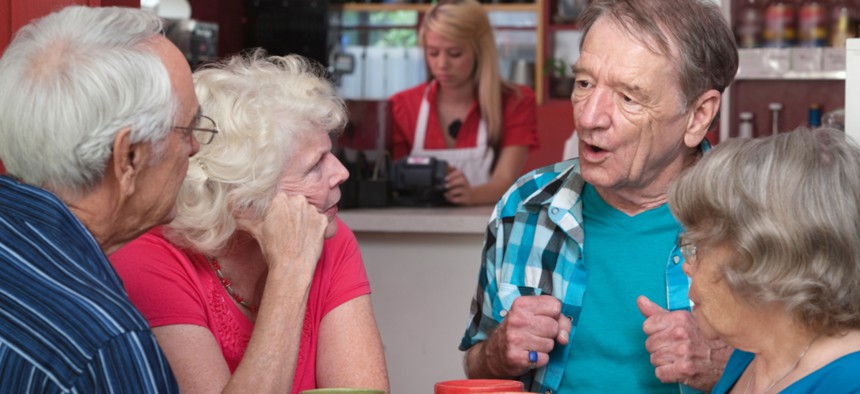To Influence Local Politics, Showing Up to Vote Isn’t Enough

Cities in California where seniors had more chances to form a group identity were more likely to have transit policy that favored them. Shutterstock

Connecting state and local government leaders
New research focused on the political muscle of elderly voters shows that non-voting activities like community organizing and participating in advisory councils—and not just showing up at the polls—is crucial in setting the local government agenda.
While political decisions made at the city level arguably affect people’s lives the most, local politics gets the least attention from voters. Turnout rates for city elections are abysmal and, too often, voters don’t even know who’s on the ballot.
With low rates of local participation, researchers have noted that some groups have outsized influence on municipal politics simply because they vote in greater numbers, as is the case in some cities where voter turnout in local elections among residents 65 and older is seven times as high as that of voters ages 18 to 34. Other researchers have found that organized groups that engage in non-voting political activities—like letter writing campaigns, lobbying, and participating in city council meetings—are particularly powerful influencers of policy.
New research from the University of California, Berkeley, compares these two metrics—voter turnout and non-political participation—and suggests that the latter is far more influential on local policy outcomes. “A vote in favor of a candidate could show preference on a variety of issues,” said Sarah Anzia, a professor of public policy and political science at the university. “But if an individual is part of an interest group that is engaging in targeted activities, the policy signal has the potential to be much clearer.”
To study the issue, Anzia focused on the involvement of seniors in local politics, and compared that statistic to the likelihood that a city had a transit policy friendly to seniors—namely a demand response service, which is a van or small bus operation run by the city that elderly people can call for rides.
Anzia then tried to determine if the presence of this kind of transit service was in response to a high voter turnout rate from seniors or their level of non-voting engagement. She measured the percentage of the electorate made up of seniors in 433 cities across California. In 104 of the cities studied, seniors were more than one-third of all voters in local elections, and in a typical city, seniors voted 20 to 30 percentage points higher than younger residents.
Anzia found that there was no correlation between the strength of older voter electoral participation and the likelihood of friendlier transit policies. “That showed voting itself isn’t the thing that influences policy,” she said.
She then collected data to measure the cohesiveness of seniors, using two proxies: the existence of senior centers and senior commissions, which are advisory groups of older people to city councils. The probability of a demand response transit system in a city with no senior center or commision was 26%. In cities with either a senior commission or senior centers, that number rose to 39%. And in places with both a senior commission and senior centers, the probability of a city implementing demand response transit reached 54%.
That shows that seniors are more likely to influence policy outcomes when they’re a cohesive lobbying group, Anzia said. “When they have opportunities to socialize, organize political functions and form a group identity, they’re more likely to develop a set of policy demands and take action on them,” she said. “Once they’re cohesive, politicians know how to respond to them.”
The key difference between being a big portion of the electorate and being an organized group, Anzia said, is shared characteristics versus shared identity. “I think the core idea here is very general,” she said. “It’s not limited to seniors. We often assume that people with similar characteristics have similar views. But that may not be the case. Once they become a united political force, that’s when politicians respond.”
Politicians tend to agree. In the 2017 Menino Survey of Mayors, which surveyed 115 city leaders from across the country, 60% said they were more influenced by a “small group with strong views” than they were by “majority public opinion.”
Katherine Levine Einstein, a Boston University professor who led the mayor survey, also studied the influence of public participation in zoning debates in Massachusetts, finding that the people who turn up at open meetings about housing development are often unrepresentative of the sentiments of the general public.
In that study, researchers said they found that people going to meetings were biased in “troubling ways” and suggested that small, organized interest groups could be bucking what the rest of their communities might want.
But Anzia said that for many local issues it isn’t easy to know what the rest of the community wants. Unlike issues debated on the national stage, like reproductive rights and gun control, city officials often lack data on what percentage of the population is for or against various policy changes. “It’s one of the hardest things to study in local democracy,” she said. “We just don’t have a lot of surveys on what people think about local policies.”
Even if public opinion data was available for every proposed local policy, Anzia said she wasn’t sure if that data would be useful for measuring how responsive a government is to interest groups versus majority opinion—because unlike abortion and firearms, most people don’t have strong opinions on issues like trash collection, transit services, and public pension funding.
“So what if we did have comprehensive opinion surveys on local politics? A lot of the public would respond ‘no preference’ because they aren’t familiar with the issues,” she said. “And it’s precisely on the issues people know the least about that interest groups can have the most influence. The opposition simply isn’t there.”
Emma Coleman is the assistant editor for Route Fifty.

NEXT STORY: How Communities Can Build Psychological Resilience to Disaster





